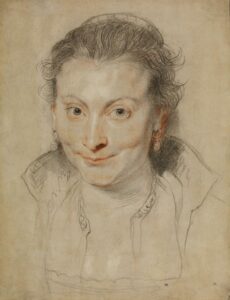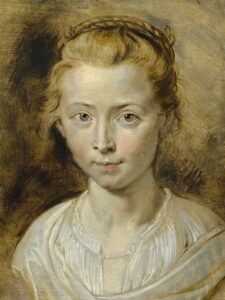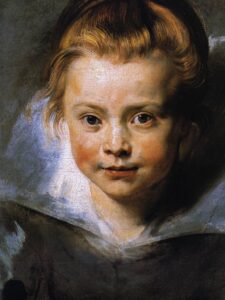Timeline 1626: Drawing of Isabella Brant

After 17 years of marriage to Rubens, Isabella Brant died in 1626 at the age of 35. In only one of his letters, Rubens sketches her character in a few sentences.
Isabella Brant talks:
Do you like this drawing? I certainly do! I know I’m not the most beautiful woman in Antwerp, but anyway, a few years ago, my husband Peter Paul asked me to sit down because he wanted to draw my portrait. I hope it gives you some idea of what our marriage was like: in his presence I felt so lively and loved that I just couldn’t help smiling.
And with just a few lines of pencil and chalk, he managed to capture that feeling perfectly.


Sadly, this portrait also reminds me of his drawing of our little girl, our daughter Clara Serena who died at the age of 12 in 1623, a shadow of her former self.
Peter Paul had made a painting of her when she was about five or six years old: her cheeks all rosy and flushed, she radiates zest for life.
She was growing into such a lovely young lady when she died and you can feel her father’s tender affection for her in both portraits.
Peter Paul portrayed me more than once with real paint. The first time was, when I turned 18 and we were joined in marriage. That is to say: we are sitting together under a honeysuckle bower, a symbol of fidelity and marital love.
Our families had been living close to each other. They had known each other for a long time; my father, Jan Brant, was a secretary to the city council and his father, Jan Rubens, had been an alderman.
I look after the household, not after the apprentices; however, let me tell you something. Peter Paul’s best pupil – as he puts it himself – Anthony van Dyck, followed his master’s example and went to Italy in October 1621. But before he left, he gave me another portrait as a present. That’s me, sitting in front of a red curtain, with our courtyard and as a backdrop the beautiful gate to the garden, a real Antwerp landmark designed by Peter Paul himself!
As you can see, we are a well-to-do couple. Peter Paul is a court painter to our beloved archdukes in Brussels, but he is allowed to live and work in Antwerp. A few years ago, he bought this property and he had his studio built according to his own design. He was so eager to show me the drawings he had made of the palazzi in Genova. His studio, this piece of sunny Italian architecture has really brightened up our northern city.
________________
Van Dyck would not see Isabella alive again; she died on June 20, 1626; the plague had been spreading in Antwerp for a year, but it hasn’t been established whether this was the real cause of her death. The statement at the time only said:
“from quick and contagious disease”/”haestige ende smettelijke ziekte (vande peste)”
Peter Paul once described the inner beauty of his deceased wife in a few sentences. They were dressed up as Latin philosophical reflections on Fate (the letter is written in Italian to Pierre Dupuy, dated July 15, 1626):
“I have indeed lost an excellent companion, whom one could, nay, should love, with good reason, because she had none of the vices of her sex. She was not capricious nor weak, but so good, so sincere and so loved for her virtues during her life, and so mourned by all after her death. Such a loss seems to me to be worth much sorrow indeed. Because the true remedy for all suffering is oblivion, daughter of Time, I ‑ without doubt ‑ hope for salvation from it. But I find it very difficult to separate the grief of loss from the memory of the person I have to love and honour for as long as I live.”
Continued on Timeline: 1635 – Helena Fourment and her children
